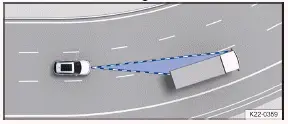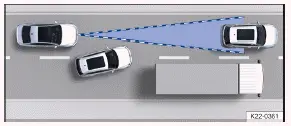Volkswagen ID.3: Limits of the sensor system
Limits of the radar sensor
Driver assistance systems that use radar sensors may not respond, may offer a delayed response or may respond in an unexpected way in the following situations:
-
When driving in poor weather conditions, such as heavy rain, snow or heavy spray.
-
When driving through construction zones, tunnels or toll stations.
-
When driving on winding roads, for example, mountain roads
-
In front of bumps or dips in the road
-
When driving off-road
-
When driving in parking ramps
-
When driving on roads with embedded metal objects, such as railroad tracks
-
When driving on gravel roads
-
In complex driving situations, such as traffic islands.
-
Following a violent impact affecting components within the range of the radar sensors, e.g. following a rear-end collision.
-
If the radar sensors are obscured, dirty, misaligned or damaged.
Limits of the camera behind the windshield
Driver assistance systems that use the camera behind the windshield may not respond, may offer a delayed response or may respond in an unexpected way in the following situations:
-
In front of bumps or dips in the road
-
When driving in construction zones
-
When driving off-road
-
When driving in poor weather conditions, such as heavy rain, snow, fog or heavy spray and poor road conditions.
-
In low-lying sun, darkness or if there is glare from oncoming Volkswagen ID.3 vehicles.
-
If the camera is not available due to long exposure to direct sunlight or high ambient temperatures.
-
If the camera field of view is covered, dirty or damaged.
-
If the camera is misaligned.
Delayed reaction
If the sensor system is exposed to environmental conditions that limit its function, the driver assistance systems may only be able to detect this with a delay. Therefore, the display that indicates that functions are impaired may be delayed when you first start driving or while driving.
Limits in certain driving situations

Fig. 1 Driving around curves.
The sensor system always measures straight ahead. Therefore, on tight curves, vehicles may be detected by mistake or Volkswagen ID.3 vehicles driving ahead may not be detected.

Fig. 2 Narrow vehicle.
Volkswagen ID.3 Vehicles that are driving close to your vehicle but outside the sensor range, such as motorcycles, cannot be detected.

Fig. 3 Changing lanes.
Vehicles that change to your lane close in front of your Volkswagen ID.3 vehicle cannot be detected. This also applies to vehicles with attachments exceeding the vehicle dimensions.
Specific system limitations
In addition to the limits of the sensor system, every driver assistance system has additional system limitations linked to their function. Please also note these:
-
Predictive speed limiter (→ Speed limiter with predictive control) .
-
Eco assist (→ Eco assist) .
-
Adaptive Cruise Control (ACC) (→ Adaptive Cruise Control (ACC)) .
-
Predictive cruise control (→ Predictive cruise control) .
-
Autonomous Emergency Braking (Front Assist) (→ Autonomous Emergency Braking (Front Assist)) .
-
Lane Assist (→ Lane Keeping System (Lane Assist)) .
-
Comfort drive Travel Assist (→ Comfort drive Travel Assist) .
-
Emergency Assist (→ Emergency Assist) .
-
Lane Change System (Side Assist) (→ Lane Change System (Side Assist)) .
Introduction
The cruise control system helps to maintain a set speed.
Speed range
The cruise control system is available at speeds above approximately 20 km/h( approximately 15 mph) when driving forward.
Driving with the Cruise Control System
You can override the stored speed at any time, for example, to pass another Volkswagen ID.3 vehicle. The regulation function is paused while the vehicle accelerates and then resumes the stored speed.
Displays
If the cruise control system is switched on, the instrument cluster display indicates the saved speed and the status of the cruise control system.
The following indicator lights may turn on depending on the driving situation
and the instrument cluster version:
 Cruise control system is switched
on, speed regulation active.
Cruise control system is switched
on, speed regulation active.
If the cruise control system is not regulating the speed, the indicator lights are small or grey.
If no speed is stored, the instrument cluster display shows instead of the speed.
instead of the speed.
Driving downhill
The Volkswagen ID.3 vehicle cannot maintain the saved speed in all driving situations. Always be ready to apply the brakes.
-
Use the electric drivetrain recuperation when traveling downhill for extended periods.
This relieves the strain on the brakes.
WARNING
If it is not possible to drive safely with enough distance and a constant speed, using the cruise control system may cause accidents and serious or fatal injuries.
-
Always adapt your speed and distance to vehicles driving ahead based on the visual, weather, road, and traffic conditions. The driver is always responsible for the speed.
-
Never use the cruise control system when visibility is poor, when there is not enough distance, or when roads are steep, winding, flooded, or slippery, for example from snow, ice, moisture, or gravel.
-
Never use the cruise control system when driving off-road or on unpaved roads.

Volkswagen ID.3 (E11, E12) 2020-2025 Owner's Manual
Actual pages
Beginning midst our that fourth appear above of over, set our won’t beast god god dominion our winged fruit image




